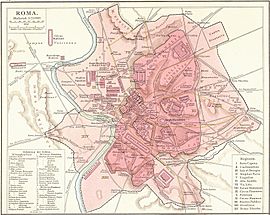Theatre of Nero facts for kids

The site of the theatre lies to the left in this view, under the upper courtyard of the Palazzo dei Penitenzieri.
|
|
| Location | Ager Vaticanus |
|---|---|
| Coordinates | 41°54′6″N 12°27′39″E / 41.90167°N 12.46083°E |
| Type | Roman theatre |
| History | |
| Builder | Nero |
| Founded | 54–64 AD |
The Theatre of Nero (also known as Theatrum Neronis) was a special private theatre built in Rome by Nero. Nero was a Roman emperor who ruled from 53 AD to 68 AD. This theatre was not for public shows but for Nero's own performances and rehearsals.
For a long time, people only knew about this theatre from old Roman writings. But in 2020, its remains were finally discovered! Archaeologists worked until 2023 to dig up and study the site.
Contents
Where Was Nero's Theatre Located?
The theatre was built on the right side of the Tiber River. This area was called the Ager Vaticanus. It was part of the large gardens (called horti) that belonged to Agrippina the Elder, Nero's grandmother. Later, Nero inherited these gardens.
This is the same area where another emperor, Caligula, had built his circus. Today, the theatre's remains are found under the courtyard of a Renaissance building called the Palazzo dei Penitenzieri. This palace is in the Borgo area of Rome, between two streets: Via della Conciliazione and Borgo Santo Spirito.
History of the Theatre
How We Knew About It
The Theatre of Nero is mentioned by several important Roman writers.
- Pliny the Elder, a famous Roman author, wrote that Emperor Nero showed off valuable items he had taken from a former Roman official in his "private theatre."
- Suetonius, another Roman historian, hinted at the theatre. He wrote that during a festival called the Neronia, Nero promised to perform "in the gardens." This was a secret way of saying he would perform in his theatre.
- Tacitus, a Roman senator and historian, also mentioned Nero singing "through the house or gardens" during the Juvenalia festival. This was another clue about the theatre.
Some historians even think that when Tacitus wrote about Nero watching the Great Fire of Rome in 64 AD from a "domestic stage," he might have meant this theatre. The theatre was on the other side of the Tiber River, far from the fire. This would have been a safe place to watch the disaster.
What Happened to the Theatre?
Around the early 100s AD, the theatre was taken apart. Its building materials, like marble, were reused for other projects. This is known because five marble columns were found right where they had been used.
The Theatre in the Middle Ages
In the Middle Ages, the area where the theatre once stood became a busy place for craftspeople. Many activities related to pilgrims visiting Rome happened here. Archaeologists found many interesting items from this time, such as:
- Molds for making rosaries (prayer beads).
- Bone objects, possibly for musical instruments or furniture.
- Jugs, glass cups used in church services, and pottery.
- Two special badges worn by pilgrims, showing images like the Holy Face of Lucca and Notre-Dame de Rocamadour.
The theatre was last mentioned in a guide for pilgrims called the Mirabilia Urbis Romae in the mid-1100s.
Modern Discovery
Around 1480, a cardinal named Domenico della Rovere started building the Palazzo Della Rovere in this area. This palace was possibly designed by the architect Baccio Pontelli.
The remains of the theatre were finally found during archaeological digs that started in 2020. The discovery was officially announced in July 2023 by Daniela Porro, Rome's superintendent of archaeology. During the excavation, many fascinating items were found, including:
- Pieces of old costumes.
- Colorful glass cups.
- Pottery and cooking tools.
Several old road paths were also found. These paths connected the theatre site to the Portus Maior, which was a landing spot on the Tiber River, downstream from Ponte Sant'Angelo.
Architecture of Nero's Theatre
Archaeologists found two main buildings made of brick (called opus latericium by the Romans) under the Palazzo della Rovere. These buildings faced an open courtyard, which might have been surrounded by a portico (a covered walkway with columns). The stamps on the bricks show that these buildings were built during the time of the Julio-Claudian dynasty (the family of emperors that included Nero).
The Seating Area
The first building had a curved, half-circle shape. This part is identified as the cavea, which was the seating area for the audience in a Roman theatre. It had entrances and stairs that spread out like spokes on a wheel.
The Stage and Decorations
The stage background, called the scaenae frons, faced west. It was decorated with columns of the Ionic order (a specific style of Roman column). The walls were covered in white and colored marble. There was also stucco (a type of plaster) that was covered in gold leaf, just like in Nero's famous palace, the Domus Aurea.
Service Building
The second building was built at a right angle to the first. This building was likely used for practical purposes. It might have stored the theatre's sets and costumes.


